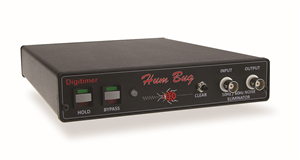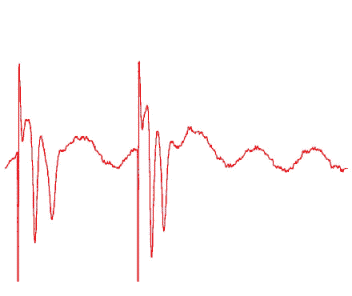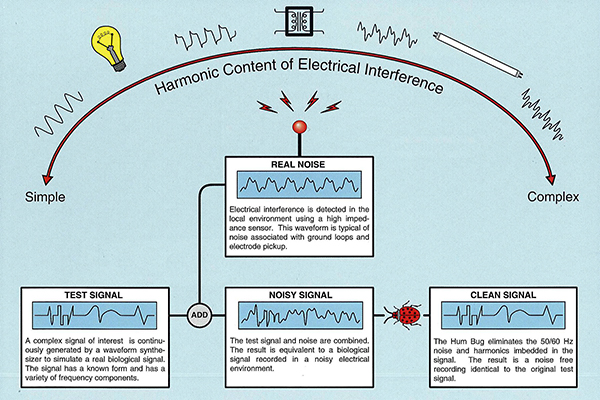

HUM BUG
HumBug Noise Eliminator; Eliminate 50/60 Hz noise and harmonics without filtering
- Overview
- Specifications
- Accessories
- Citations
- Related Products
Overview

There are 1 images available to view - click to enlarge and scroll through the product gallery.
Hum Bug Instruction Manual
/ Download as PDF
Eliminates Electrical Interference
- Simple 50/60 Hz Sine Waves
- Mixtures of 50/60 Hz Harmonics
- Noise Spikes from Dimmers
- Complex Noise from Fluorescent Lamps
No Waveform Distortion
- No Frequency Loss
- No DC Voltage Shift
- No Signal Attenuation
- No Phase Error
The Hum Bug Noise Eliminator is the ideal piece of biological research technology, aiding in the removal of mains or line noise (50/60Hz) in signal readings from biological sensors and high impedance devices, without the signal degradation associated with notch filters.
A New Solution
WPI is proud to distribute the Hum Bug -- a new approach to Noise Control. This is a powerful new technology for cancelling electrical interference in real-time, avoiding all of the traditional problems associated with notch filters. The HumBug constructs a replica of noise present on the input signal and continuously subtracts this replica from the signal as it passes through the instrument. It performs this function in the presence of biological activity even when noise characteristics evolve over time.
Advantages
The HumBug is not a filter. It does not create phase delays, amplitude errors, DC shifts or waveform distortion. Simply connect it between your preamplifier and any analysis equipment and it will automatically eliminate 50/60 Hz noise and harmonics with frequencies up to several kHz. Noise is eliminated without altering the signal of interest even when frequencies within the signal overlap with noise components. No settings or adjustments are required.

A hippocampal recording contaminated with line noise. The physiological signal remains intact as the HumBug removes the imbedded line noise.
What can the Humbug do for your experiments?
TRADITIONAL CONCERNS: Signals recorded using biological an other high impedance devices are often contaminated with 50/60* Hz noise and harmonics originating from power supplies, power mains and lights. The presence of noise corrupts the information content of these signals an can degrade the quality of subsequent data analysis. This electrical interference is notoriously difficult to remove without altering the original signal imbedded within the noise.
In theory, proper attention to grounding and appropriate shielding can eliminate electrical interference. In practice, noise remains a frequent and distressing problem in the daily operation of many laboratories. Even with diligent attention to details, noise may come and go for no apparent reason and may appear during critical phases of data collection. The effort required to maintain noise at an acceptable level is both time consuming and frustration.
The HumBug solves these problems.
TRADITIONAL APPROACH: Faraday cages decrease the magnitude of environmental noise sources but this protection is often incomplete and working within a cage can be cumbersome. Notch or comb filters are occasionally used to suppress 50/60 Hz noise and harmonics but these filters will distort the input waveform if frequency components of the signal overlap with the filtered frequencies.
NEW SOLUTION: The humbug has been developed with a powerful new technique to eliminate 50/60 Hz noise and harmonics from analogue signals without filtering. The HumBug constructs a noise replica in real time and continuously subtracts this replica from the input signal. It performs this function in the presence of biological activity even when noise characteristics evolve over time.
ADVANTAGES: The HumBug is not a filter. It does not create phase delays, amplitude errors, DC shifts or waveform distortion. It eliminates 50/60 Hz noise and harmonics without altering the frequency characteristics of the input signal even when these frequencies overlap with noise components.
SIMPLICITY: The HumBug is a real-time device. Simply connect it between your preamplifier and any analysis or recording equipment (oscilloscope etc..). It will automatically eliminate electrical interference while it 1ets the signal of interest pass through unchanged. No settings or adjustments are required. The front panel switches are only used if you wish to bypass cancellation (BYPASS), stop the adaptation process (HOLD), or clear the noise replica (CLEAR).
TECHNICAL OVERVIEW
THEORY OF OPERATION: Principle operations of the HumBug are illustrated on the picture above. All functions occur in parallel as the signal passes in a direct analogue path between input and output. The key innovation of the Humbug is the ability to effectively isolate noise from an input signal even when noise characteristics are evolving and frequency components of the noise and input signal overlap.
FREQUENCY RESPONSE: Biological signals pass through the HumBug unchanged for Frequency components in the range of DC to greater than 500 kHz.
COMPLEX NOISE: Electrical interference often generates a mixture of harmonics at multiples of 50/60 Hz (e.g. 100Hz, 150 Hz, 200 Hz). The HumBug eliminates all harmonics with Frequencies up to several kHz. Therefore, even the complex spikes generated by dimmers and fluorescent lamps are eliminated.
APPLICATIONS: The HumBug can eliminate 50/60 Hz noise from virtually any analogue signal. It is equally effective at removing noise associated with inadequate grounding, ground loops, and electrical pick up. Common applications include noise elimination from signals recorded using microelectrodes, skin electrodes (EKG, EMG,EEG), high gain amplifiers, magnetic sensors and audio equipment
Specifications
| Input Protection | 50V peak to peak |
| Max. Input Signal | 5V average peak to peak |
| Max. Noise Amplitude | 1V peak to peak |
| Frequency Response | DC to >500kHz |
| Noise Cancellation | 50/60Hz and harmonics to 4kHz |
| Controls |
|
| Display |
|
| Power | 115-240 VAC |
| Dimensions | 18.2 cm x 25.5 cm x 4.0 cm (WxDxH) |
| Weight | 1.5 Kg |
Accessories
Citations
Bedore, C., Loew, E., & Frank, T. (2013). A physiological analysis of color vision in batoid elasmobranchs. Journal of Comparative …. Retrieved from https://link.springer.com/article/10.1007/s00359-013-0855-1
Cuypers, K., Leenus, D., & Berg, F. van den. (2013). Long-term TENS treatment decreases cortical motor representation in multiple sclerosis. Neuroscience. Retrieved from https://www.sciencedirect.com/science/article/pii/S0306452213005526
Cuypers, K., Leenus, D., & Wijmeersch, B. Van. (2013). Anodal tDCS increases corticospinal output and projection strength in multiple sclerosis. Neuroscience …. Retrieved from https://www.sciencedirect.com/science/article/pii/S0304394013008203
Farooq, U., & Rajkumar, R. (2013). Corticotropin-releasing factor infusion into nucleus incertus suppresses medial prefrontal cortical activity and hippocampo-medial prefrontal cortical long-term. European Journal of …. Retrieved from https://onlinelibrary.wiley.com/doi/10.1111/ejn.12242/full
Haan, R. de, Lee, Y., & Nordström, K. (2013). Novel Flicker-Sensitive Visual Circuit Neurons Inhibited by Stationary Patterns. The Journal of Neuroscience. Retrieved from https://vntin.com/www.jneurosci.org/content/33/21/8980.full
Levin, S., Meesen, R., & Press, N. (n.d.). Anodal tDCS increases corticospinal output and projection strength in multiple sclerosis. Prof. dr. Ivo Lambrichts, …. Retrieved from https://uhdspace.uhasselt.be/dspace/bitstream/1942/15856/1/PhD_KoenFINAL_docserver.pdf#page=89
Liang, C., Howells, J., & Kennerson, M. (2013). Axonal excitability in X-linked dominant Charcot Marie Tooth disease. Clinical …. Retrieved from https://www.sciencedirect.com/science/article/pii/S1388245713011735
Lindgren, C., & Newman, Z. (2013). Cyclooxygenase-2, prostaglandin E2 glycerol ester and nitric oxide are involved in muscarine-induced presynaptic enhancement at the vertebrate neuromuscular. The Journal of …. Retrieved from https://onlinelibrary.wiley.com/doi/10.1113/jphysiol.2013.256727/full
Lui, L., Bourne, J., & Rosa, M. (2013). Relationship between Size Summation Properties, Contrast Sensitivity and Response Latency in the Dorsomedial and Middle Temporal Areas of the Primate. PloS one. Retrieved from https://dx.plos.org/10.1371/journal.pone.0068276
Quesseveur, G., & Repérant, C. (2013). 5-HT2A receptor inactivation potentiates the acute antidepressant-like activity of escitalopram: involvement of the noradrenergic system. Experimental Brain …. Retrieved from https://link.springer.com/article/10.1007/s00221-013-3434-3
Schäfer, D., Puschhof, A., & Schuhmann, W. (2013). Scanning electrochemical microscopy at variable temperatures. Physical Chemistry Chemical …. Retrieved from https://pubs.rsc.org/en/content/articlehtml/2013/cp/c3cp43520b
Thijs, S., & Meesen, R. (2013). Long-term TENS treatment decreases cortical motor representation in multiple sclerosis. … , co-promoter Prof. dr. Herbert Thijs, …. Retrieved from https://uhdspace.uhasselt.be/dspace/bitstream/1942/15856/1/PhD_KoenFINAL_docserver.pdf#page=73
Vasant, D., & Payton, A. (2013). The val66met polymorphism of brain-derived neurotrophic factor is associated with human esophageal hypersensitivity. …. Retrieved from https://onlinelibrary.wiley.com/doi/10.1111/nmo.12021/full
Walder, K., & Ryan, S. (2013). Immunohistological and electrophysiological evidence that N-acetylaspartylglutamate is a co-transmitter at the vertebrate neuromuscular junction. European Journal of …. Retrieved from https://onlinelibrary.wiley.com/doi/10.1111/ejn.12027/full
Webster, R., Cossins, J., & Lashley, D. (2013). A mouse model of the slow channel myasthenic syndrome: Neuromuscular physiology and effects of ephedrine treatment. Experimental …. Retrieved from https://www.sciencedirect.com/science/article/pii/S0014488613001854
Yu, H., & Rosa, M. (2013). Uniformity and diversity of response properties of neurons in the primary visual cortex: Selectivity for orientation, direction of motion, and stimulus size from center to far. Visual neuroscience. Retrieved from https://journals.cambridge.org/production/action/cjoGetFulltext?fulltextid=9057712
Zhu, X., He, L., & McCluskey, L. (2013). Ingestion of bacterial lipopolysaccharide inhibits peripheral taste responses to sucrose in mice. Neuroscience. Retrieved from https://www.sciencedirect.com/science/article/pii/S0306452213009251





Request
Catalogue
Chat
Print